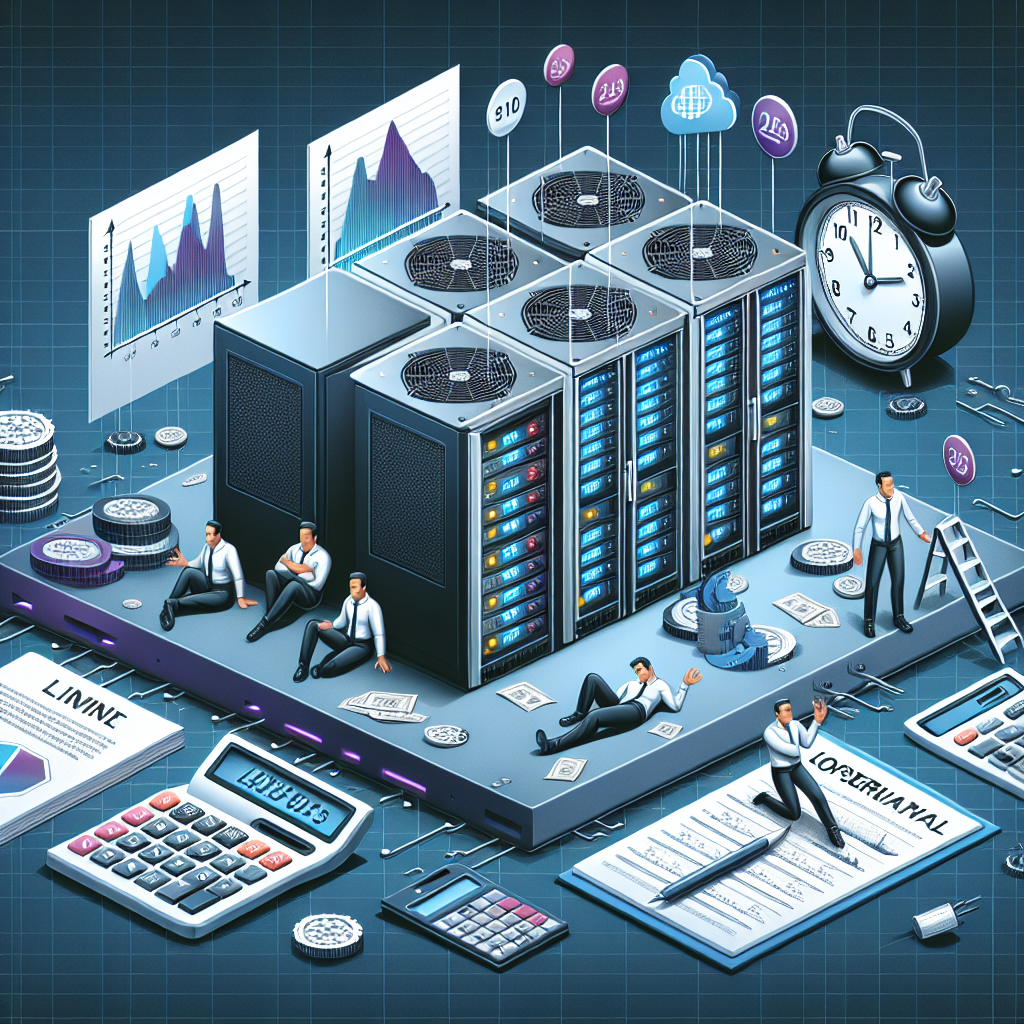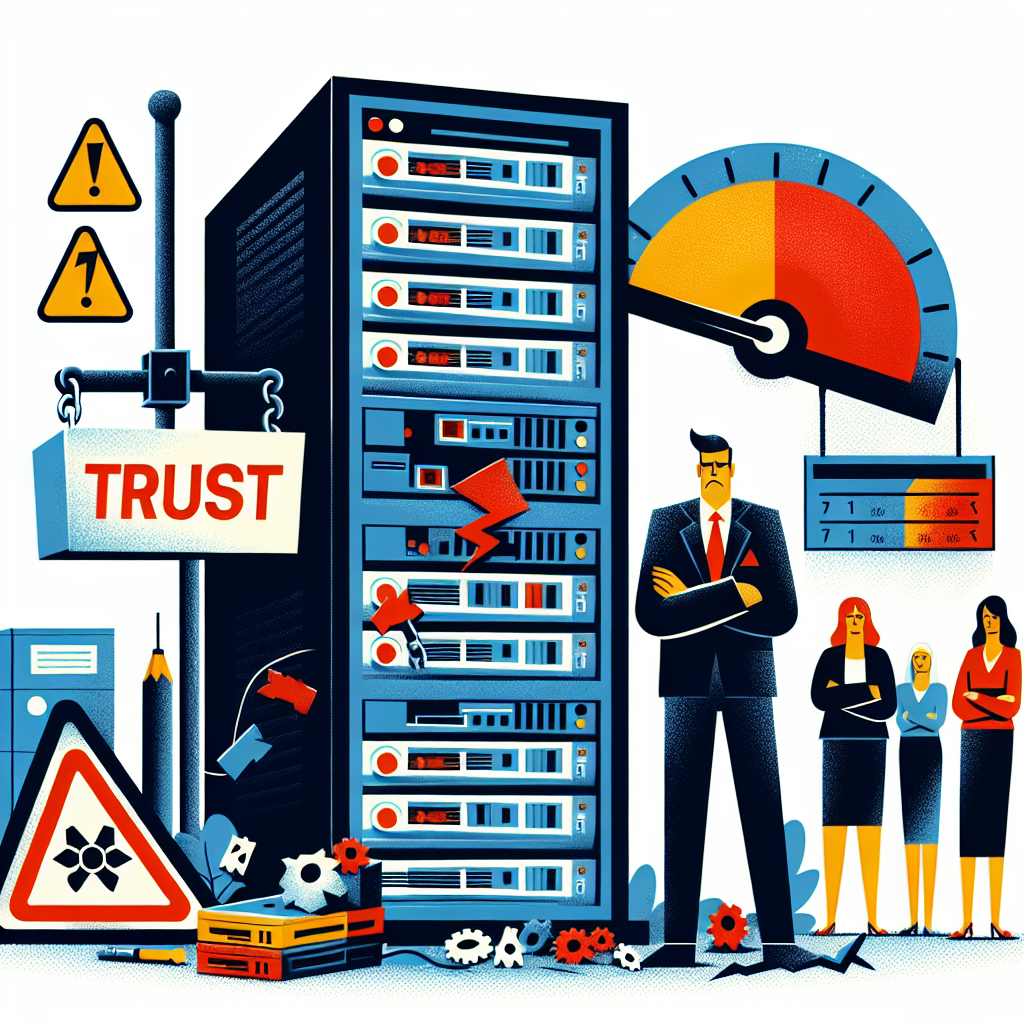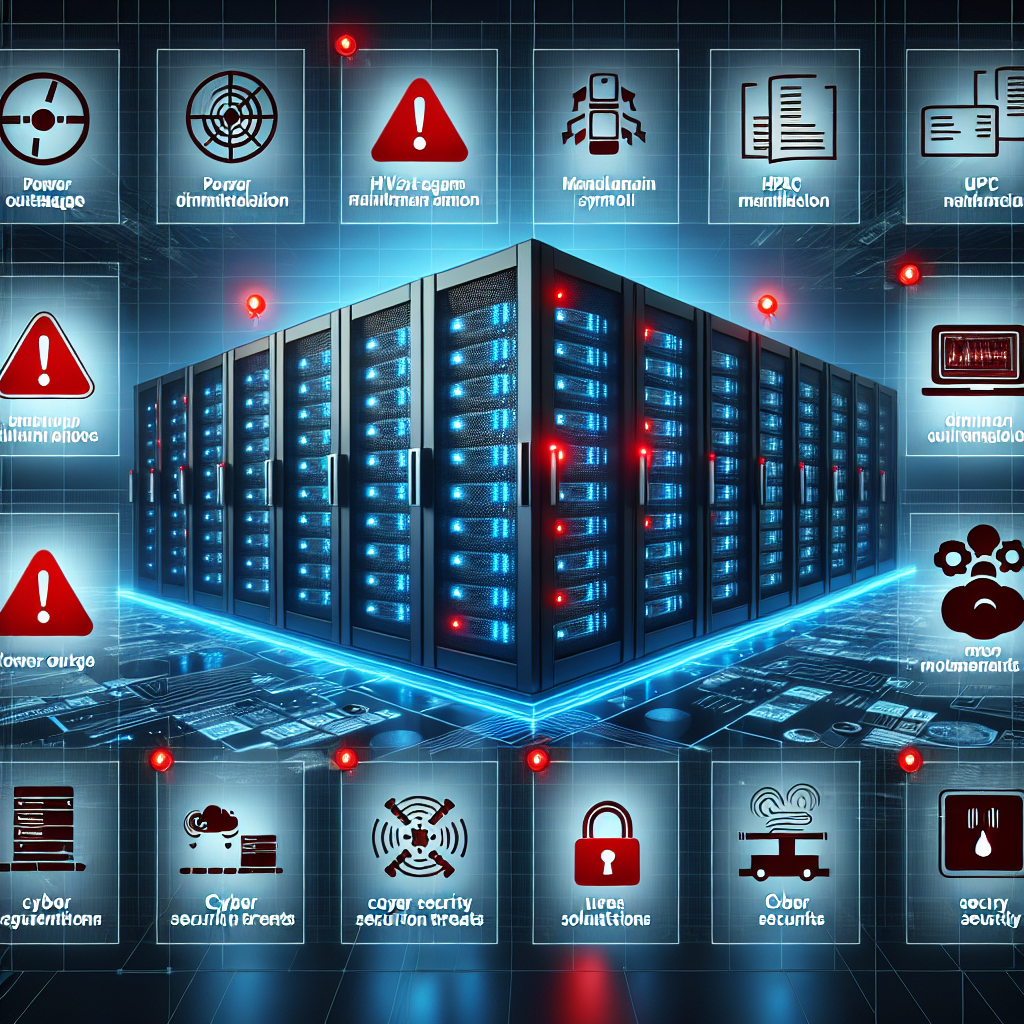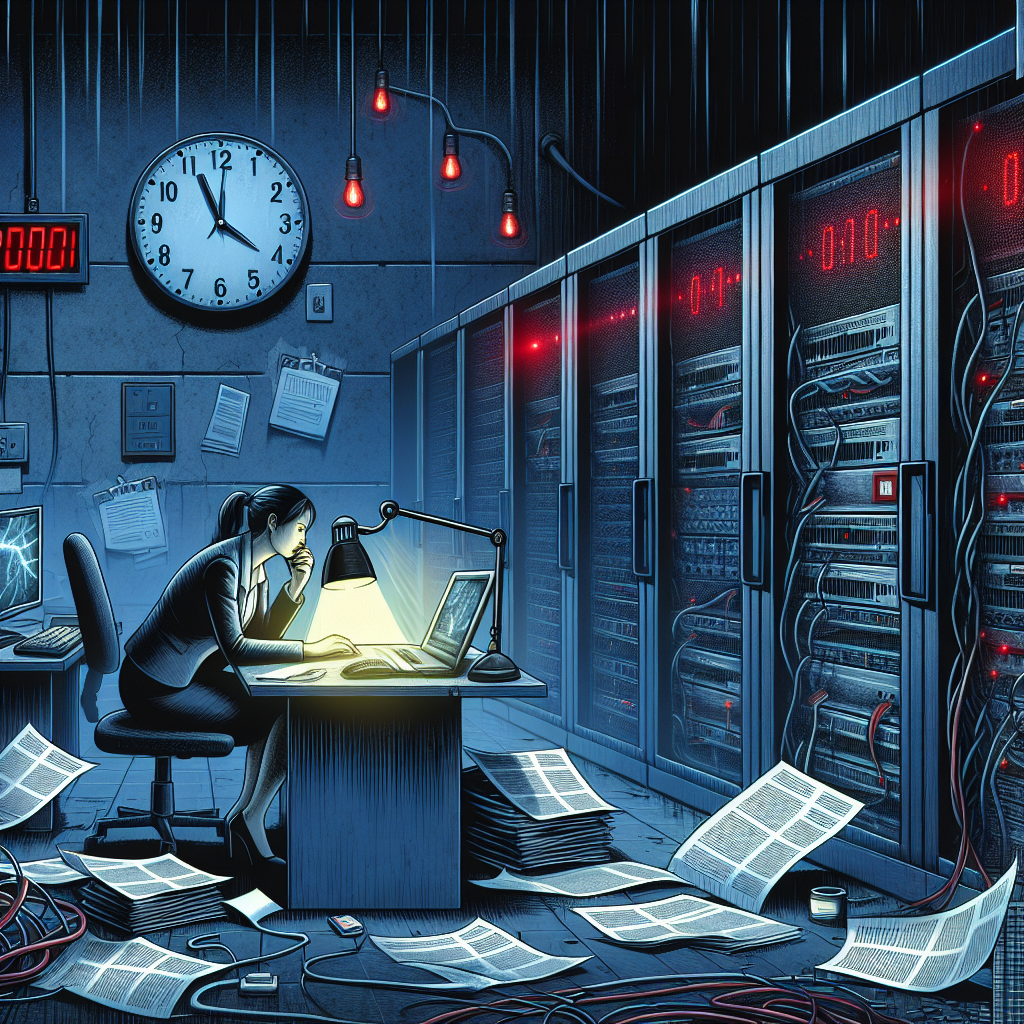Your cart is currently empty!
Tag: Data Center Downtime

Measuring the True Cost of Data Center Downtime: A Closer Look at Financial and Operational Losses
Data center downtime can have a significant impact on a company’s bottom line, both financially and operationally. In today’s digital age, data centers play a crucial role in storing and processing critical business information. When a data center experiences downtime, it can disrupt operations, lead to lost revenue, and damage a company’s reputation.To accurately measure the true cost of data center downtime, it is important to consider both the financial and operational losses that can occur. Financial losses can include lost revenue, penalties for breaching service level agreements, and the cost of repairing any damage caused by the downtime. Operational losses can include decreased productivity, loss of customer trust, and damage to a company’s reputation.
One of the most significant financial costs of data center downtime is lost revenue. When a data center goes offline, businesses are unable to access critical information and services, leading to lost sales and potential customers. Additionally, companies may be subject to penalties for failing to meet service level agreements with customers, which can further impact their bottom line.
Operational losses can also have a significant impact on a company’s overall performance. When a data center experiences downtime, employees may be unable to access the information and tools they need to perform their jobs effectively. This can lead to decreased productivity, missed deadlines, and increased stress among employees. Additionally, customers may lose trust in a company that cannot keep their data secure and accessible, leading to long-term damage to a company’s reputation.
In order to mitigate the impact of data center downtime, companies should invest in robust backup and disaster recovery solutions. These solutions can help minimize the financial and operational losses associated with downtime by ensuring that critical data and services are quickly restored in the event of an outage. Additionally, companies should regularly test their backup and disaster recovery plans to ensure they are effective in a real-world scenario.
By taking proactive measures to prevent and mitigate data center downtime, companies can minimize the financial and operational costs associated with outages. By accurately measuring the true cost of downtime, companies can make informed decisions about how to best protect their business from the potentially devastating effects of data center outages.

The Impact of Data Center Downtime on Customer Trust and Brand Reputation
Data centers are the backbone of modern businesses, providing the infrastructure necessary to store and process vast amounts of data. However, when these data centers experience downtime, the consequences can be severe. Not only does downtime result in lost revenue and productivity, but it can also have a significant impact on customer trust and brand reputation.When a data center goes down, it can disrupt essential services and operations, leaving customers unable to access their data or services. This can lead to frustration and dissatisfaction among customers, who may choose to take their business elsewhere in search of a more reliable service provider. In fact, studies have shown that downtime can have a lasting impact on customer loyalty, with many customers citing poor service reliability as a key reason for switching to a competitor.
In addition to the immediate loss of revenue and customers, downtime can also have a long-term impact on a company’s brand reputation. In today’s digital age, where consumers rely heavily on technology for everyday tasks, a company’s ability to provide reliable and secure services is crucial to maintaining a positive brand image. When a data center experiences downtime, it can erode customer trust and confidence in the company’s ability to deliver on its promises.
Furthermore, downtime can also have a ripple effect on a company’s overall reputation, as negative experiences are often shared on social media and review platforms. This can further damage a company’s credibility and make it difficult to attract new customers in the future.
To mitigate the impact of data center downtime on customer trust and brand reputation, companies must prioritize proactive measures to prevent downtime and ensure the reliability of their data center infrastructure. This includes implementing redundant systems, investing in regular maintenance and monitoring, and having a comprehensive disaster recovery plan in place.
In conclusion, the impact of data center downtime on customer trust and brand reputation cannot be underestimated. Companies must take proactive steps to prevent downtime and ensure the reliability of their data center infrastructure in order to maintain customer loyalty and protect their brand image in today’s competitive market.

Understanding the Causes of Data Center Downtime and How to Mitigate Them
Data centers are the backbone of modern businesses, providing the infrastructure necessary for storing, processing, and distributing data. However, despite their critical importance, data centers are vulnerable to downtime, which can have severe consequences for businesses, including lost revenue, damaged reputation, and decreased productivity. Understanding the causes of data center downtime is the first step in mitigating these risks.One of the most common causes of data center downtime is power failure. Power outages can occur due to a variety of reasons, including grid failures, equipment malfunctions, and severe weather events. To mitigate the risk of power failure, data centers should have backup power systems in place, such as uninterruptible power supply (UPS) units and generators. These systems can provide emergency power to critical equipment during outages, ensuring that operations can continue uninterrupted.
Another common cause of data center downtime is cooling system failure. Data centers generate a significant amount of heat due to the constant operation of servers and other equipment. Cooling systems are essential for maintaining optimal temperatures within the data center and preventing equipment from overheating. To mitigate the risk of cooling system failure, data centers should have redundant cooling systems in place and regularly maintain and test these systems to ensure they are functioning properly.
Human error is another significant cause of data center downtime. Mistakes made by employees, such as accidentally unplugging equipment or misconfiguring systems, can lead to downtime and potential data loss. To mitigate the risk of human error, data centers should invest in training programs for employees and implement strict protocols for handling equipment and making changes to systems. Additionally, automation tools can help reduce the likelihood of human error by automating routine tasks and minimizing manual intervention.
Natural disasters, such as earthquakes, floods, and hurricanes, can also cause data center downtime. While it may be impossible to prevent natural disasters from occurring, data centers can mitigate the impact of these events by implementing disaster recovery and business continuity plans. These plans should outline procedures for quickly restoring operations in the event of a disaster, including data backup and recovery strategies, alternative workspaces, and communication protocols.
In conclusion, data center downtime can have severe consequences for businesses, but by understanding the causes of downtime and implementing mitigation strategies, data centers can minimize the risk of disruption. By investing in backup power systems, redundant cooling systems, employee training, and disaster recovery plans, data centers can ensure that they are prepared to handle unexpected events and maintain operations without interruption.

The Hidden Risks of Data Center Downtime: Why Redundancy is Key
In today’s digital age, data centers have become the backbone of businesses, storing and processing vast amounts of critical information. However, with this reliance on data centers comes the risk of downtime, which can have serious consequences for organizations. In fact, according to a recent study by Ponemon Institute, the average cost of data center downtime is $740,357 per incident.There are a number of factors that can cause data center downtime, including power outages, hardware failures, and cyber attacks. Regardless of the cause, the impact of downtime can be severe. Beyond the financial costs, downtime can also damage a company’s reputation, erode customer trust, and lead to lost productivity.
One of the key ways to mitigate the risks of data center downtime is through redundancy. Redundancy refers to the practice of having backup systems and components in place to ensure continuous operation in the event of a failure. This can include redundant power supplies, cooling systems, and network connections.
By implementing redundancy in their data centers, organizations can greatly reduce the likelihood of downtime and minimize its impact if it does occur. For example, if a power outage were to occur, a data center with redundant power supplies would be able to switch to a backup power source seamlessly, ensuring that critical systems remain operational.
In addition to hardware redundancy, organizations should also consider implementing redundancy in their data center design and location. This can include having multiple data centers in different geographic locations to ensure continuity in the event of a natural disaster or other regional event.
While implementing redundancy may require additional upfront investment, the costs of downtime far outweigh the costs of redundancy. By investing in redundancy, organizations can protect their critical systems and data, minimize the risks of downtime, and ensure business continuity in the face of unforeseen events.
In conclusion, the risks of data center downtime are significant and can have serious consequences for organizations. By implementing redundancy in their data centers, organizations can greatly reduce the likelihood of downtime and protect their critical systems and data. Redundancy is key to ensuring business continuity and mitigating the risks of data center downtime in today’s digital age.

Preventing Data Center Downtime: Best Practices for Effective Disaster Recovery Planning
Data centers are the backbone of modern businesses, housing the critical infrastructure and data that keep organizations running smoothly. However, despite their importance, data centers are not immune to downtime. Whether caused by natural disasters, power outages, hardware failures, or human error, data center downtime can have catastrophic consequences for businesses, leading to lost revenue, damaged reputation, and even legal implications.To prevent data center downtime and protect your organization from the costly repercussions, it is essential to have an effective disaster recovery plan in place. Here are some best practices for creating a comprehensive disaster recovery plan that will minimize the risk of downtime and ensure business continuity.
1. Conduct a thorough risk assessment: Before creating a disaster recovery plan, it is crucial to identify and assess potential risks that could lead to data center downtime. Consider factors such as location, environmental threats, hardware vulnerabilities, human error, and cybersecurity risks. Understanding these risks will help you prioritize your disaster recovery efforts and allocate resources effectively.
2. Develop a robust backup strategy: Regularly backing up critical data and systems is essential for disaster recovery planning. Implement a multi-tiered backup strategy that includes on-site and off-site backups, as well as cloud backups for added redundancy. Test your backup systems regularly to ensure they are functioning correctly and can be quickly restored in the event of a disaster.
3. Implement high availability solutions: To minimize the risk of downtime, consider implementing high availability solutions such as redundant power supplies, uninterruptible power supplies (UPS), backup generators, redundant network connections, and failover systems. These technologies can help ensure continuous operation of critical systems even in the event of a hardware failure or power outage.
4. Create a detailed disaster recovery plan: Develop a comprehensive disaster recovery plan that outlines specific procedures to follow in the event of a data center outage. Include contact information for key personnel, step-by-step recovery instructions, and a timeline for restoring operations. Regularly review and update the plan to reflect changes in technology, infrastructure, and business needs.
5. Test your disaster recovery plan: Regularly test your disaster recovery plan through simulated drills and exercises to ensure that all systems and personnel are prepared to respond effectively in the event of a real disaster. Identify and address any weaknesses or gaps in your plan to improve its effectiveness and minimize downtime.
6. Monitor and analyze performance: Implement monitoring tools and performance metrics to track the health and performance of your data center infrastructure. Proactively identify and address potential issues before they lead to downtime, and use data analytics to optimize your disaster recovery plan and improve resilience.
By following these best practices for effective disaster recovery planning, you can minimize the risk of data center downtime and protect your organization from the costly consequences of unplanned outages. Investing in a robust disaster recovery plan is essential for ensuring business continuity and maintaining the trust of your customers and stakeholders.

The Real Cost of Data Center Downtime: Calculating the Financial and Reputational Damage
Data centers are the backbone of modern businesses, housing the critical IT infrastructure that keeps operations running smoothly. However, despite their importance, data center downtime is a common occurrence that can have severe financial and reputational implications for organizations.The financial impact of data center downtime can be staggering. According to a report by the Ponemon Institute, the average cost of a data center outage is $9,000 per minute. This means that even a short period of downtime can result in significant financial losses for a company. In fact, the same report found that the average total cost of a single data center outage is over $740,000.
But the financial costs are just the tip of the iceberg when it comes to the true cost of data center downtime. The reputational damage that can result from a data center outage can be even more devastating. Customers today expect 24/7 access to services and products, and any disruption in service can lead to a loss of trust and loyalty.
In a digital age where news spreads rapidly through social media and online forums, a data center outage can quickly become a public relations nightmare. Customers may take to social media to vent their frustrations, leading to negative press coverage and a tarnished reputation for the company.
In addition to the financial and reputational costs, there are also intangible costs associated with data center downtime. These include lost productivity, missed opportunities, and decreased employee morale. When critical systems are down, employees are unable to perform their jobs effectively, leading to a decrease in overall productivity.
So, how can organizations calculate the true cost of data center downtime? One approach is to use a downtime calculator, which takes into account factors such as revenue loss, employee productivity, and reputational damage. By inputting these variables, organizations can get a clearer picture of the financial and reputational impact of a data center outage.
Ultimately, the real cost of data center downtime goes far beyond just the financial losses. It can have a lasting impact on a company’s reputation, customer trust, and employee morale. By understanding the full scope of the consequences of downtime, organizations can better prepare for and mitigate the risks associated with data center outages.

Data Center Downtime: Why Proactive Monitoring and Maintenance are Essential
In today’s digital age, data centers play a crucial role in storing and processing vast amounts of information for businesses and organizations. However, data center downtime can have catastrophic consequences, leading to loss of revenue, damaged reputation, and even legal implications. That’s why proactive monitoring and maintenance are essential to ensure the smooth operation of data centers.Data center downtime can occur due to a variety of reasons, including hardware failures, power outages, network issues, and human error. It’s crucial for data center managers to constantly monitor the performance of their infrastructure to detect potential issues before they escalate into downtime. Proactive monitoring involves using advanced tools and technologies to track the health and performance of servers, storage systems, networking equipment, and other critical components.
By monitoring key performance indicators such as temperature, humidity, power usage, and network traffic, data center managers can identify potential issues and take corrective action before they lead to downtime. For example, if a server is running hot, it could be a sign of a failing cooling system, which could eventually cause the server to fail. By proactively monitoring temperature levels, data center managers can address the issue before it leads to downtime.
In addition to proactive monitoring, regular maintenance is also essential to prevent downtime. This includes conducting routine inspections, testing backup systems, replacing worn-out components, and upgrading software and firmware. By staying on top of maintenance tasks, data center managers can ensure that their infrastructure remains reliable and resilient.
Furthermore, data center managers should have a comprehensive disaster recovery plan in place to minimize the impact of downtime. This includes regularly backing up data, having redundant systems in place, and testing the disaster recovery plan to ensure it works effectively in case of an emergency.
Overall, proactive monitoring and maintenance are essential practices for data center managers to ensure the smooth operation of their infrastructure. By staying vigilant and proactive, data center managers can prevent downtime, minimize disruptions, and protect their organization’s critical data and systems.

Mitigating the Risks of Data Center Downtime: Tips for IT Leaders
Data center downtime can be a costly and disruptive issue for businesses, causing loss of revenue, damage to reputation, and hindered productivity. As an IT leader, it is crucial to have a plan in place to mitigate the risks of data center downtime and ensure the smooth operation of your organization’s IT infrastructure. Here are some tips for IT leaders to prevent and manage data center downtime:1. Conduct Regular Maintenance and Monitoring: Regular maintenance of your data center equipment is essential to prevent unexpected failures. Make sure to schedule routine inspections, testing, and updates to keep your systems running smoothly. Additionally, implement monitoring tools to track the performance of your data center and detect any potential issues before they escalate.
2. Implement Redundancy and Backup Systems: To minimize the impact of hardware failures or power outages, it is important to have redundancy and backup systems in place. This includes redundant power supplies, backup generators, and failover mechanisms to ensure continuous operation in the event of a failure.
3. Have a Disaster Recovery Plan: In the event of a major outage or disaster, having a comprehensive disaster recovery plan in place is crucial. This plan should outline the steps to be taken to restore operations, including data backups, alternative communication channels, and procedures for contacting key stakeholders.
4. Train Your Staff: Ensure that your IT team is well-trained in data center operations and disaster recovery procedures. Regular training sessions and drills can help your team respond effectively in the event of a downtime incident.
5. Monitor Environmental Conditions: Environmental factors such as temperature, humidity, and air quality can impact the performance of your data center equipment. Implement monitoring systems to track these conditions and address any issues that may arise.
6. Regularly Test Your Systems: Regularly testing your data center systems and disaster recovery procedures is essential to ensure their effectiveness. Conducting simulated downtime scenarios can help you identify any weaknesses in your systems and make necessary improvements.
7. Stay Up-to-Date on Industry Trends: Stay informed about the latest developments in data center technology and best practices. By staying ahead of the curve, you can implement new solutions and strategies to prevent downtime and keep your data center running smoothly.
By following these tips, IT leaders can mitigate the risks of data center downtime and ensure the reliable operation of their organization’s IT infrastructure. Proactive planning, regular maintenance, and effective response strategies are key to minimizing the impact of downtime incidents and keeping your business running smoothly.

The Consequences of Data Center Downtime: A Wake-Up Call for Businesses
In today’s digital age, data centers are the backbone of businesses, providing the infrastructure needed to store, process, and transmit large amounts of data. However, data center downtime can have serious consequences for businesses, leading to lost revenue, damaged reputation, and even legal repercussions. As such, it is crucial for companies to take proactive measures to prevent downtime and ensure business continuity.One of the most immediate consequences of data center downtime is lost revenue. In today’s highly competitive market, even a few hours of downtime can result in significant financial losses. According to a report by the Ponemon Institute, the average cost of data center downtime is $9,000 per minute. For a large enterprise, this can add up to millions of dollars in lost revenue over the course of a single outage.
In addition to lost revenue, data center downtime can also damage a company’s reputation. Customers expect uninterrupted access to services and products, and any disruption in service can lead to frustration and dissatisfaction. This can result in customers taking their business elsewhere, leading to long-term financial consequences for the company.
Furthermore, data center downtime can also have legal repercussions for businesses, especially in industries that are heavily regulated. For example, in the healthcare industry, data center downtime can lead to violations of patient privacy laws and result in hefty fines. Similarly, in the financial services industry, downtime can lead to breaches of security regulations and put customer data at risk.
Given the serious consequences of data center downtime, businesses must take proactive measures to prevent outages and ensure business continuity. This includes implementing robust backup and disaster recovery plans, regularly testing systems for vulnerabilities, and investing in redundant infrastructure to minimize the risk of downtime.
In conclusion, data center downtime can have serious consequences for businesses, including lost revenue, damaged reputation, and legal repercussions. Companies must take proactive measures to prevent downtime and ensure business continuity in order to protect their bottom line and maintain the trust of their customers. As the digital landscape continues to evolve, businesses must prioritize the reliability and resilience of their data center infrastructure to stay ahead of the competition.

Preventing Data Center Downtime: Strategies for Ensuring Business Continuity
Data centers are the backbone of modern businesses, housing critical IT infrastructure and storing vast amounts of data. Any downtime in a data center can have severe consequences for a business, leading to lost revenue, damaged reputation, and potential security breaches. Therefore, it is essential to have strategies in place to prevent data center downtime and ensure business continuity.One of the most effective ways to prevent data center downtime is to invest in redundant systems and infrastructure. Redundancy ensures that if one component fails, another can seamlessly take over, minimizing the impact on operations. This includes redundant power supplies, cooling systems, and network connections, as well as backup generators and uninterruptible power supplies (UPS) to keep the data center running in the event of a power outage.
Regular maintenance and monitoring of data center equipment are also crucial in preventing downtime. This includes performing routine inspections, testing backup systems, and monitoring performance metrics to identify potential issues before they escalate into full-blown outages. Implementing a comprehensive monitoring and alerting system can help data center operators quickly respond to any abnormalities and take corrective action to prevent downtime.
Another key strategy for preventing data center downtime is to implement a robust disaster recovery plan. This plan should outline how the business will continue operations in the event of a data center outage, including backup and recovery procedures, communication protocols, and alternative locations for critical operations. Regularly testing and updating the disaster recovery plan ensures that it remains effective in the face of evolving threats and technologies.
Physical security is also a critical component of preventing data center downtime. Data centers house valuable assets and sensitive information, making them a prime target for physical attacks. Implementing access controls, surveillance cameras, and security protocols can help prevent unauthorized access and protect the data center from physical threats.
In addition to these strategies, it is essential for businesses to have a comprehensive business continuity plan that outlines how they will continue operations in the face of a data center outage. This plan should include communication strategies, alternative work locations, and procedures for accessing critical data and applications remotely.
In conclusion, preventing data center downtime is essential for ensuring business continuity and protecting the bottom line. By investing in redundant systems, regular maintenance, disaster recovery planning, physical security, and business continuity planning, businesses can minimize the risk of data center outages and ensure that their operations continue uninterrupted in the face of unforeseen events.
